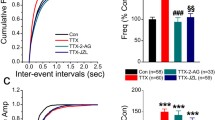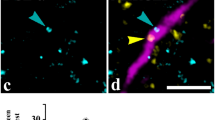Abstract.
The monoacylglycerol 2-arachidonylglycerol is an endogenous ligand of cannabinoid receptors. We examined whether 2-arachidonylglycerol can influence excessive neuronal activity by investigating stimulation-induced population spikes and epileptiform activity in rat hippocampal slices. For this purpose, the effects of 2-arachidonylglycerol were compared with those of the synthetic cannabinoid agonist WIN 55,212-2.
At concentrations of 10–50 µM, 2-arachidonylglycerol attenuated the amplitude of the orthodromic population spike and the slope of the field excitatory postsynaptic potential (field EPSP). However, the effect of the synthetic cannabinoid WIN 55,212-2 (R(+)-[2,3-dihydro-5-methyl-3-[(morpholinyl)methyl]pyrrolol[1,2,3-de]-1,4-benzoxazinyl]-(1-naphthalenyl)methanone; 0.1 µM and 1 µM) was significantly higher than that of the endogenous ligand. At a concentration of 1 µM, WIN 55,212-2 completely suppressed the field EPSP. However, none of the investigated compounds did affect the presynaptic fiber spike of the afferents. The CB1 receptor antagonist SR 141716 (N-piperidino-5-(4-chlorophenyl)-1-(2,4-dichlorphenyl)-4-methyl-3-pyrazole-carboxamide) blocked the inhibition evoked by the cannabinoids.
Both 2-arachidonylglycerol (30 µM) and WIN 55,212-2 (100 nM) shifted the input-output curve of the postsynaptic spike and the field EPSP to the right and increased the magnitude of paired-pulse facilitation, indicating a presynaptic mechanism of action.
2-Arachidonylglycerol and WIN 55,212-2 attenuated the frequency of spontaneously occurring epileptiform burst discharges in CA3 elicited by omission of Mg2+ and elevation of K+ to 8 mM. The antiepileptiform effect of these cannabinoids was blocked by SR 141716.
In conclusion, 2-arachidonylglycerol seems to limit neuronal excitability via cannabinoid receptors of the CB1 type. By acting predominantly at a presynaptic site, it is capable of reducing excitatory neurotransmission, a mechanism which might be involved in the prevention of excessive excitability leading to epileptiform activity.
Similar content being viewed by others
Author information
Authors and Affiliations
Additional information
Electronic Publication
Rights and permissions
About this article
Cite this article
Ameri, A., Simmet, T. Effects of 2-arachidonylglycerol, an endogenous cannabinoid, on neuronal activity in rat hippocampal slices. Naunyn-Schmiedeberg's Arch Pharmacol 361, 265–272 (2000). https://doi.org/10.1007/s002109900200
Received:
Accepted:
Issue Date:
DOI: https://doi.org/10.1007/s002109900200




